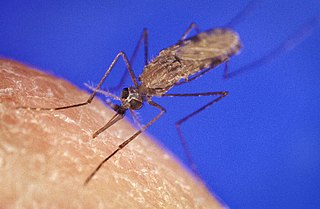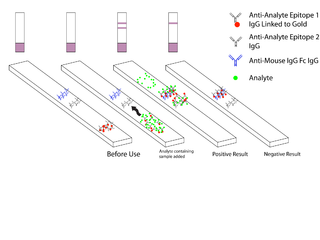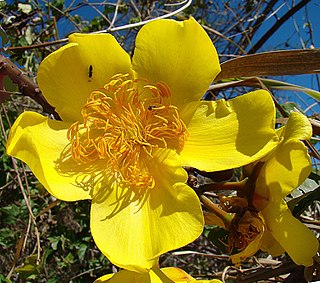
Borotutu is traditional medicine made from the African tree Cochlospermum angolense . It is widespread in parts of Angola, where it is known as mburututu in the Chokwe and Kimbundu languages. [1]

Borotutu is traditional medicine made from the African tree Cochlospermum angolense . It is widespread in parts of Angola, where it is known as mburututu in the Chokwe and Kimbundu languages. [1]
Borututu bark is claimed to have hepatic healing properties and a general cleansing effect. Borotutu bark pills and herbal teas are sold in health stores. The bark showed activity against the rodent malaria parasite Plasmodium berghei in laboratory tests. [2]
In Ghana, where the bark locally known as paajawu, it is added to Shea Butter during the boiling process for a vibrant yellow coloring.

Malaria is a mosquito-borne infectious disease that affects vertebrates. Human malaria causes symptoms that typically include fever, fatigue, vomiting, and headaches. In severe cases, it can cause jaundice, seizures, coma, or death. Symptoms usually begin 10 to 15 days after being bitten by an infected Anopheles mosquito. If not properly treated, people may have recurrences of the disease months later. In those who have recently survived an infection, reinfection usually causes milder symptoms. This partial resistance disappears over months to years if the person has no continuing exposure to malaria.

Plasmodium berghei is a single-celled parasite causing rodent malaria. It is in the Plasmodium subgenus Vinckeia.
Plasmodium chabaudi is a parasite of the genus Plasmodium subgenus Vinckeia. As in all Plasmodium species, P. chabaudi has both vertebrate and insect hosts. The vertebrate hosts for this parasite are rodents.

The Anopheles gambiae complex consists of at least seven morphologically indistinguishable species of mosquitoes in the genus Anopheles. The complex was recognised in the 1960s and includes the most important vectors of malaria in sub-Saharan Africa, particularly of the most dangerous malaria parasite, Plasmodium falciparum. It is one of the most efficient malaria vectors known. The An. gambiae mosquito additionally transmits Wuchereria bancrofti which causes lymphatic filariasis, a symptom of which is elephantiasis.

Malaria culture is a method for growing malaria parasites outside the body, i.e., in an ex vivo environment. Although attempts for propagation of the parasites outside of humans or animal models reach as far back as 1912, the success of the initial attempts was limited to one or just a few cycles. The first successful continuous culture was established in 1976. Initial hopes that the ex vivo culture would lead quickly to the discovery of a vaccine were premature. However, the development of new drugs was greatly facilitated.

Artelinic acid is an experimental drug that is being investigated as a treatment for malaria. It is a semi-synthetic derivative of the natural compound artemisinin. Artelinic acid has a lower rate of neurotoxicity than the related artemisinin derivatives arteether and artemether, but is three times more toxic than artesunate. At present, artelinic acid seems unlikely to enter routine clinical use, because it offers no clear benefits over the artemesinins already available. Artelinic acid has not yet been evaluated for use in humans.

Malaria antigen detection tests are a group of commercially available rapid diagnostic tests of the rapid antigen test type that allow quick diagnosis of malaria by people who are not otherwise skilled in traditional laboratory techniques for diagnosing malaria or in situations where such equipment is not available. There are currently over 20 such tests commercially available. The first malaria antigen suitable as target for such a test was a soluble glycolytic enzyme Glutamate dehydrogenase. None of the rapid tests are currently as sensitive as a thick blood film, nor as cheap. A major drawback in the use of all current dipstick methods is that the result is essentially qualitative. In many endemic areas of tropical Africa, however, the quantitative assessment of parasitaemia is important, as a large percentage of the population will test positive in any qualitative assay.
Vinckeia is a subgenus of the genus Plasmodium — all of which are parasitic alveolates. The subgenus Vinckeia was created by Cyril Garnham in 1964 to accommodate the mammalian parasites other than those infecting the primates.
Malaria vaccines are vaccines that prevent malaria, a mosquito-borne infectious disease which affected an estimated 249 million people globally in 85 malaria endemic countries and areas and caused 608,000 deaths in 2022. The first approved vaccine for malaria is RTS,S, known by the brand name Mosquirix. As of April 2023, the vaccine has been given to 1.5 million children living in areas with moderate-to-high malaria transmission. It requires at least three doses in infants by age 2, and a fourth dose extends the protection for another 1–2 years. The vaccine reduces hospital admissions from severe malaria by around 30%.

Cochlospermum is a genus of trees in the Bixaceae family; some classifications place this genus in the family Cochlospermaceae. It is native to tropical regions of the world, particularly Latin America, Africa, the Indian Subcontinent, and Australia.

The history of malaria extends from its prehistoric origin as a zoonotic disease in the primates of Africa through to the 21st century. A widespread and potentially lethal human infectious disease, at its peak malaria infested every continent except Antarctica. Its prevention and treatment have been targeted in science and medicine for hundreds of years. Since the discovery of the Plasmodium parasites which cause it, research attention has focused on their biology as well as that of the mosquitoes which transmit the parasites.

Cipargamin is an experimental synthetic antimalarial drug belonging to the spiroindolone class. The compound was developed at the Novartis Institute for Tropical Diseases in Singapore, through a collaboration with the Genomics Institute of the Novartis Research Foundation (GNF), the Biomedical Primate Research Centre and the Swiss Tropical Institute.
Pregnancy-associated malaria (PAM) or placental malaria is a presentation of the common illness that is particularly life-threatening to both mother and developing fetus. PAM is caused primarily by infection with Plasmodium falciparum, the most dangerous of the four species of malaria-causing parasites that infect humans. During pregnancy, a woman faces a much higher risk of contracting malaria and of associated complications. Prevention and treatment of malaria are essential components of prenatal care in areas where the parasite is endemic – tropical and subtropical geographic areas. Placental malaria has also been demonstrated to occur in animal models, including in rodent and non-human primate models.
Circumsporozoite protein (CSP) is a secreted protein of the sporozoite stage of the malaria parasite and is the antigenic target of RTS,S and other malaria vaccines. The amino-acid sequence of CSP consists of an immunodominant central repeat region flanked by conserved motifs at the N- and C- termini that are implicated in protein processing as the parasite travels from the mosquito to the mammalian vector. The amino acid sequence of CSP was determined in 1984.
Cochlospermum angolense is a tree in the family Bixaceae. It is native to Angola and the Democratic Republic of the Congo. An extract of the tree's bark, called Borotutu in African traditional medicine, has been studied in mice for its potential to treat malaria.

Cochlospermum vitifolium or rosa amarilla is a tree belonging to the family Bixaceae. It reaches up to 12 metres (40 ft) in height and its leaves are deciduous. Its flowers are showy, yellow, solitary, and large, up to 10 centimetres (4 in) across. They resemble roses but do not belong to the same family. It inhabits the dry jungles of southern Mexico to Central America from sea level to 1,200 metres (3,900 ft) elevation. Its wood produces a yellow-orange dye used for dyeing cotton clothes.

Quartan fever is one of the four types of malaria which can be contracted by humans.

Rita Tewari is an Indian parasitologist who studies the cell and molecular biology of malaria. She currently holds a post as professor at the University of Nottingham.
Irène Landau is a French parasitologist and professor emeritus at the National Museum of Natural History, France (MNHN) and Centre national de la recherche scientifique.
Annickia polycarpa is a small to medium-sized tree found in evergreen forests of West and Central Africa, it is within the Annonaceae family. It is also called the African Yellow wood.